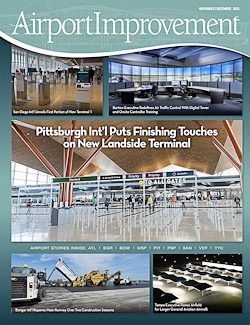Over the past several years, I have wondered if we have come full circle, where the Professional Engineer (P.E.) is the only eligible profession to lead an Engineering and Airport Planning and Development Department or Engineering and Planning Department. This is because many postings for these positions list only P.E.s in their “Preferred Requirements,” while other professionals with designations such as AIA (American Institute of Architects) or AICP (American Institute of Certified Planners) are rarely mentioned.
Amazingly, the answer to this question was given by the federal government in response to the U.S. Urban Renewal and National Highway Era, from the 1940s to the 1970s. During that time, interrelated programs aimed to revitalize urban areas by demolishing buildings and homes deemed to be substandard and, in turn, redevelop them with new construction and roadway connections to other cities.
 Sheldon Daisley, AAE, AICP, has been an airport planning practitioner for the past 25 years and is currently grants planning manager for a multi-airport system in the southwest U.S.. Previously, he worked on the consulting side of the business for Parsons Brinckerhoff Aviation and HNTB. During that time, he developed master plans, land use plans, land use ordinances, facility plans and/or environmental assessments for several major U.S. airports. |
The programs brought significant national economic benefits, but also social upheaval and environmental decay. Such issues prompted criticism from individuals such as Jane Jacobs, Robert F. Williams, John Francis and Charles Young, not to mention non-profit groups like the Environmental Defense Fund, the Natural Resources Defense Council (NRDC) and the Sierra Club.
So, what is the connection between this history and today’s trend of airports hiring engineers to lead their Planning, Development and Capital Improvement departments?
The Urban Renewal and National Highway programs embodied an era of weak planning. However, the activism they inspired led to a spate of federal regulations that require a multi-stakeholder planning process with a wide spectrum of input from various professions to help identify impacts before construction. Such associated legislation included the National Environmental Policy Act (1969), the Clean Air Act (1970) and the Resources Conservation and Recovery Act (1976). Within the aviation sector, regulations included Order 1050, 5050- 4b, AC 150/5070, AC 150/5300-13, just to name a few. The AAAE Body of Knowledge modules chronicle the history of airport development with corresponding federal acts, orders and advisory circulars.
In my opinion, an Airport Planning and Development Department does not necessarily need a P.E. to lead it, but a professional uniquely knowledgeable in planning, organizing and fulfilling federal requirements to shepherd the capital program from inception to implementation.
What does that entail? It starts with visioning, which yields ideas that need to be translated into actionable goals and objectives through planning. When executed, the tasks/projects outlined during planning should create outcomes that achieve the vision and goals initially identified.
One crucial part of the planning process is identifying the most feasible location to construct capital projects. This is the bread-and-butter skillset of a “pure airport planner,” and it is often overlooked! The ideal site for a new facility enables it to connect seamlessly with the overall airport fabric, and operational efficiencies can abound.
New facilities are too often arbitrarily placed just to be near available green space. On the contrary, a professional planner develops a land use plan or facilities plan that groups compatible uses next to each other and thus promotes future growth of those uses, while also reducing incompatible uses that would create costly relocations in the future.
This brings to mind cities like Chicago, Dallas, Denver and Houston, which all needed to build new airports outside of their city centers largely because they failed to protect/plan the surroundings of their original airports to accommodate future growth.
It is critical to infuse planning techniques to avoid the need to relocate major assets in the future. Take, for instance, the “Barn” at Phoenix Sky Harbor (PHX), a two-story structure built nearly 20 years ago on beachfront property between the airport’s landside and airside areas—a prime location for terminal expansion. For years, the Barn has housed office staff (not a revenue-producing function). Now, however, the building must be demolished before the end of its lifecycle to make room for more lucrative uses.
Another example is the Rental Car Center at George Bush Intercontinental Airport (IAH) located south of Runway 9-27 at the northern edge of undeveloped property. If it had instead been co-located with a nearby EcoPark and Ride facility on the southern edge of IAH, the airport would have a multi-use transportation node in the south, thus leaving this area for future runway or terminal expansion.
All said, planning is just as important as engineering—for vertical structures and flat work, too.
A Capital Improvement Program needs to be structured not only for operational functionality, but also to meet federal requirements and be environmentally sound. It benefits, not only from engineers, but a plethora of subject matter experts to address the entire process from visioning and planning through construction and operational readiness for opening day.
Two of my early mentors—Jill Tiedt, AICP and Arnold Rosenberg, P.E.—stressed that airports are much like cities and assured me an urban planning degree would apply well to a career developing airports. They were absolutely right.
Note: The views expressed in this article are solely those of the author, not his current or former employers.


